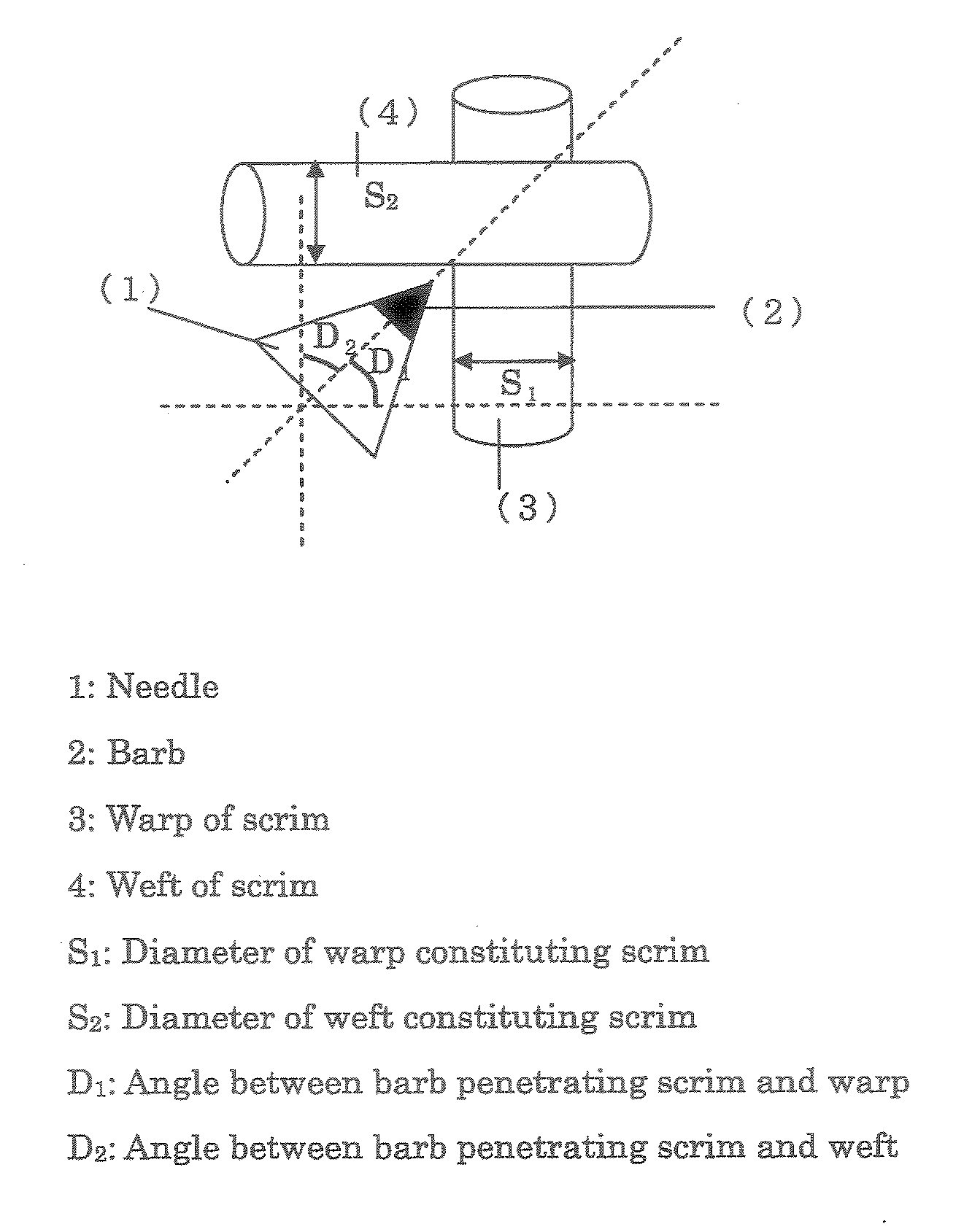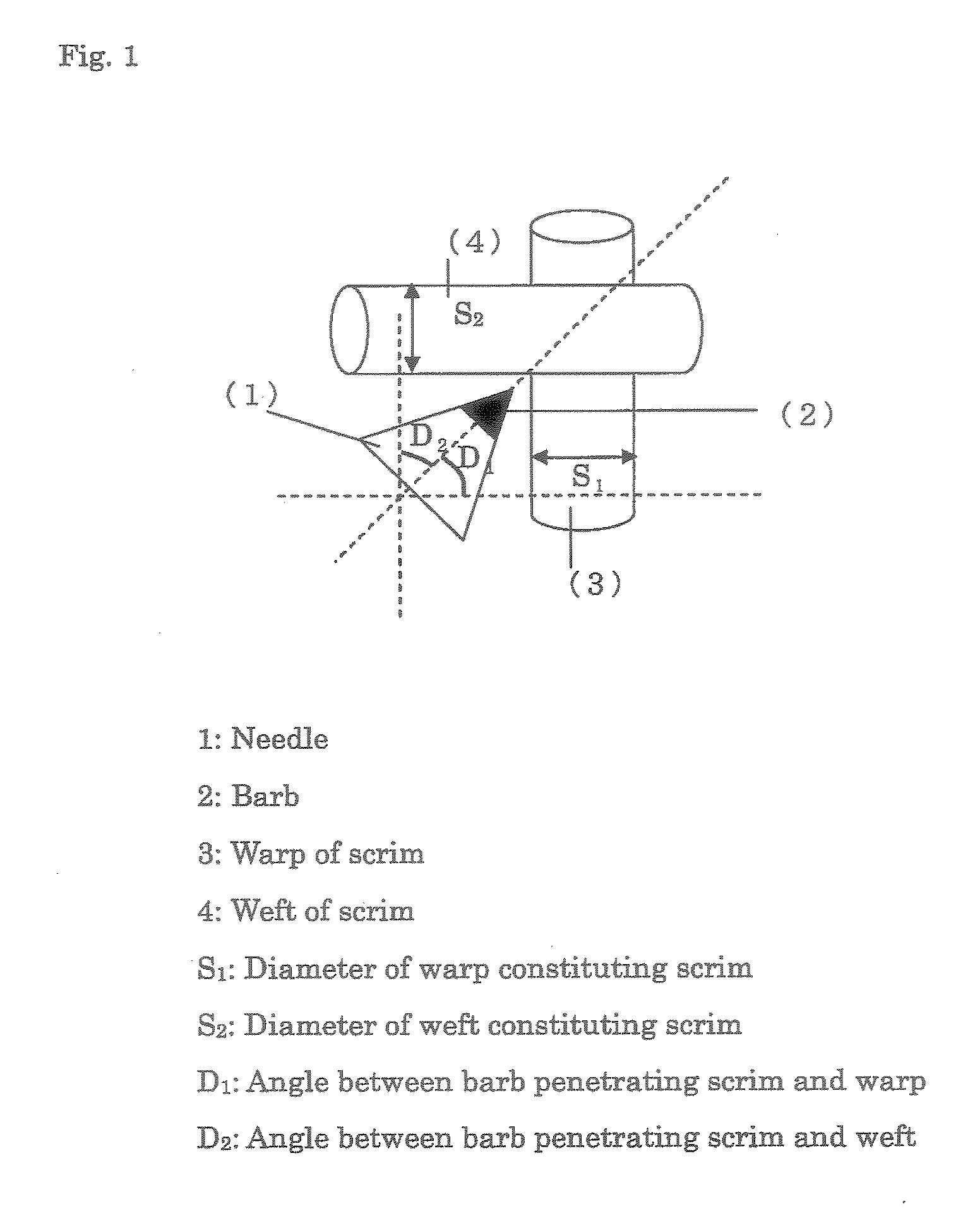Nonwoven Fabric For Artificial Leather And Process For Producing Artificial Leather Substrate
a nonwoven fabric and artificial leather technology, applied in the field of producing nonwoven fabrics for artificial leather and artificial leather substrates, can solve the problems of inability to meet the high shape stability simultaneously, damage of fibers, undesirable changes and damage in the structure of nonwoven fabrics and scrim, etc., to achieve low scrim damage, high tenacity and shape stability, and low cost
- Summary
- Abstract
- Description
- Claims
- Application Information
AI Technical Summary
Benefits of technology
Problems solved by technology
Method used
Image
Examples
example 1
[0051]The following staples of sea-island composite fibers were used:
[0052]island component: polyethylene terephthalate,
[0053]sea component: polystyrene,
[0054]area ratio on fiber cross section: island component / sea component=65 / 35,
[0055]number of island component: 16,
[0056]fineness: 4.4 dtex, and
[0057]fiber length: about 50 mm.
[0058]The staples were carded and superposed by a crosslapper to obtain a web. The web was then needle-punched at a density of 560 punch / cm2 to obtain a fiber web having a mass per unit area of 223 g / m2.
[0059]Between two fiber webs, was interposed a plain weave scrim made of yarns of a fineness of 54 dtex, 24 filaments, a twist number of 500 T / m, S1 of 170 □m and S2 of 170 □m. The superposed fiber webs and scrim were needle-punched from the upper and back surfaces at a punching density of 690 punch / cm2 (total 1380 punch / cm2) using a needle board. On the needle board, single barb needles having a total barb depth P of 100 □m were implanted, which were arranged ...
example 2
[0063]A nonwoven fabric for artificial leather and substrate for artificial leather were produced in the same manner as in Example 1 except for using the following staples of sea-island composite fibers:
[0064]island component: polyethylene terephthalate,
[0065]sea component: polystyrene,
[0066]area ratio on fiber cross section: island component / sea component=75 / 25,
[0067]number of island component: 50
[0068]fineness: 4.6 dtex, and
[0069]fiber length: about 50 mm.
[0070]As shown in Table 1, the breaking strength of the obtained nonwoven fabric for artificial leather was 16 kg / 2.5 cm in the length direction and 12 kg / 2.5 cm in the width direction. The fiber web made of superfine fibers with a single fiber fineness of 0.02 dtex and scrim were firmly united and the reinforcing effect of the scrim was sufficient even after made into a substrate for artificial leather. The obtained substrate for artificial leather favorably combined a sufficient strength with a soft feel.
example 3
[0071]A nonwoven fabric for artificial leather, substrate for artificial leather and suede artificial leather were produced in the same manner as in Example except for using a plain weave scrim made of yarns (S1 and S2 were both 170 □m) with a number of twists of 500 T / m which was constituted by the same fibers as used in the fiber web. The obtained substrate for artificial leather and suede artificial leather combined a sufficient strength with an extremely soft feel. The properties are shown in Table 1.
PUM
| Property | Measurement | Unit |
|---|---|---|
| length | aaaaa | aaaaa |
| diameter | aaaaa | aaaaa |
| elastic | aaaaa | aaaaa |
Abstract
Description
Claims
Application Information
 Login to View More
Login to View More - R&D
- Intellectual Property
- Life Sciences
- Materials
- Tech Scout
- Unparalleled Data Quality
- Higher Quality Content
- 60% Fewer Hallucinations
Browse by: Latest US Patents, China's latest patents, Technical Efficacy Thesaurus, Application Domain, Technology Topic, Popular Technical Reports.
© 2025 PatSnap. All rights reserved.Legal|Privacy policy|Modern Slavery Act Transparency Statement|Sitemap|About US| Contact US: help@patsnap.com


